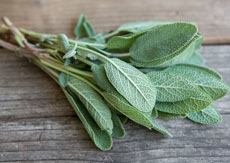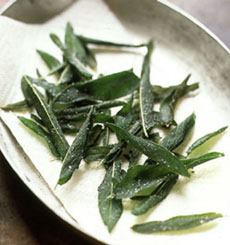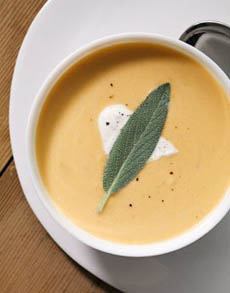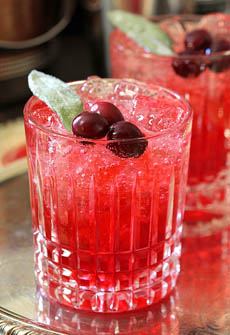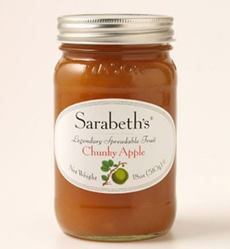TIP OF THE DAY: Ways To Use Fresh Sage, From Cocktails Through Dessert
|
We love fresh sage, but seem to use it mostly in the fall. We use it in stuffing, flash-fried as a garnish, and with cocktails. But of course, you can enjoy it year-round. It’s a standard herb blend with parsley, rosemary and thyme, a key component of poultry and sausage seasonings. Our mom put fresh sage under the skin of a chicken prior to roasting. Salvia officinalis, common sage, is a membr of the Lamiaceae family of flowering plants, also called the mint family. Members are frequently aromatic in all parts* and include many widely used culinary herbs: basil, hyssop, lavender, marjoram, mint, oregano, perilla, rosemary, sage, savory and thyme. Some are shrubs, some are trees; in rare instances, some members are vines. On this lovely fall weekend, relax with a sage-garnished cocktail and complementary hors d’oeuvre. The Side Ride cocktail, created by blogger Carey Nershi of Reclaiming Provincial, combines Cognac, Grand Marnier or other orange liqueur, sweet and sour mix (ideally homemade) and Sprite (or 7-Up) lemon-lime soda, both to taste. It’s similar to a Side Car, but substitutes gin for the Cognac. Carey took this sophisticated approach with a recipe she created for Vermont Creamery, served with hors d’oeuvre made with Vermont Creamery’s Bijou, an award-winning aged goat cheese in the style of the French crottin. Carey uses barrel-aged gin, a recently-revived practice that ages gin, like tequila—in bourbon barrels that generate more richness and spice. Wood aging also adds color, so barrel-aged gins are the color of whiskey. You can use regular gin, or use this as an occasion to try barrel aged gin. And, since this is the season for sage, the cocktail has a fresh sage leaf garnish. |
[1] Fresh sage (photo courtesy Good Eggs). [2] Fried sage leaves. Here’s the recipe from Saveur. [3] Butternut soup with a garnish of creme fraiche and a sage leaf. Here’s the recipe from Bon Appetit.[4] Sage as a cocktail garnish in everything from Martinis to this Cranbery Sage Holiday Cocktail (here’s the recipe from Creative Culinary). |
|

|
________________ *Beyond leaves and stems, these can include the herb’s bark, flowers, roots and seeds. RECIPE #1: SIDE RIDE COCKTAIL Ingredients Per Drink 1. COMBINE the gin, Grand Marnier, lemon juice and bitters in a shaker with ice. Stir 8-12 seconds and strain into chilled coupe glass. 2. RUB the rub sage leaf lightly on the rim of coupe and float the leaf in the drink along with lemon or orange peel. Carey created this hors d’oeuvre to go with the Side Ride cocktail. Slices of Bijou aged goat cheese (from Vermont Creamery) are topped with smoked salmon and a dollop of crème fraiche for a festive bite. We had a jar of Sarabeth’s Chunky Apple Jam, and found that we preferred apple jam/preserves to the caramelized apples she specifies. It’s also a lot easier to open a jar, rather than than peeling, slice and caramelize the apples. If you have another jam or chutney, that can work, too. And if you want to use caramelized apples, Carey’s recipe is below. 1. SLICE the Bijou into rounds and place on top of crackers. Top the cheese with the caramelized apples or preserves, and a piece of smoked salmon that’s size-appropriate for the cracker. 2. TOP with a dollop of crème fraîche and garnish with a small sprig of fresh dill or a piece of sage. RECIPE#3: CARAMELIZED APPLES Caramelizing is the process of converting sugar into caramel. This type of caramel is not thick like caramel sauce or caramel candies. Rather, the sugar and butter combine to create a light, caramel finish to the apples. You can use caramelized apples with everything from pancakes to pork loin. Carey uses a dab to add a sweetness counterpoint to the salty smoked salmon in the recipe above. Ingredients 1. PEEL the apples and cut them into thin slices, as if for apple pie. First cut them into quarters, then slice each quarter into 4 pieces. 2. MELT the butter over medium-high heat. Add the brown sugar, stir to combine, and add the apples. Toss the apples a few times until they are softened and caramelized. Let us know how you use them: for breakfast, lunch, dinner, snacks and desserts. |
|
|
|
||
